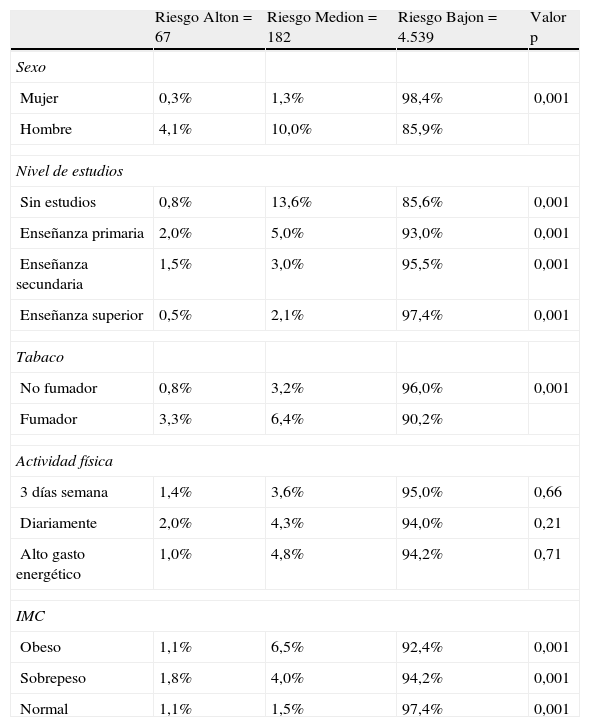Identificar el riesgo cardiovascular en la población que acude a los servicios de Atención Primaria, a través de la tabla SCORE.
MétodoEstudio descriptivo, observacional, transversal y multicéntrico en el que participaron 1324 profesionales (enfermeras, médicos, estudiantes, etc.) pertenecientes a las once Áreas Sanitarias de la Comunidad de Madrid, para determinar el riesgo cardiovascular mediante la tabla SCORE, en sujetos (40-65 años) que acudieron voluntariamente a su centro de salud con motivo del Día Europeo de la Prevención del Riesgo Cardiovascular.
ResultadosSe obtuvieron 5.025 cuestionarios recogidos en 142 centros. El 69,6% mujeres. Edad media de 53,1 años (DE: 7,4). Tuvieron un SCORE alto un 4,1%; medio un 3,9% y bajo un 92,4%. Existen diferencias significativas entre el promedio del SCORE de hombres y mujeres, siendo mayor en hombres p<0,001 (IC 95%: 0,9-1,1). Los hombres tenían un 10% más de probabilidad de tener un SCORE alto/moderado que las mujeres p<0,001 (IC 95%: 6,2-12,3). A más nivel educativo el SCORE es inferior p<0,001 (IC 95%: -1,1 -0,5). Las personas con sobrepeso y obesidad tuvieron un riesgo de 2,6 veces mayor que las normopeso p<0,001 (IC 95%: 1,7-3,9).
ConclusionesEl riesgo cardiovascular en general es bajo en personas que acuden a los centros de salud. En hombres es más probable un SCORE alto-moderado. Un bajo nivel de estudios y un sobrepeso-obesidad podrían estar asociados a un mayor riesgo de padecer un evento cardiovascular.
To quantify the cardiovascular risk in a Primary Health Care population using the SCORE chart.
MethodMulticenter, observational, descriptive study including 1324 health professionals (nurses, physicians, students, etc) employees of any of the eleven Madrid Region Health Areas in order to determinate the cardiovascular risk by the SCORE chart in subjects between 40 and 65 years that attended to their health centre in a voluntary way because of the European Day of Prevention of Cardiovascular Risk.
ResultsA total of 5025 questionnaires were collected from 142 health centres, with 69.6% being completed by women. Mean age was 53.1 years (SD 7.4). A high SCORE was found in 4.1% of the population, a medium one in 3.9%, and low in 92.4%.. There were significant differences in the mean SCORE between men and women, with men having higher ones, P<.001 (95% CI, 0.9-1.1). The probability of men of having a medium/high SCORE was 10% higher than that of women P<.001 (95% CI, 6.2-12.3). Those with higher educational levels had lower SCORE results, P<.001 (95% CI, 1.1-0.5). Obese and over weight people had a 2.6 higher risk than those of normal weight, P<.001 (95% CI: 1.7-3.9).
ConclusionsCardiovascular risk is generally low in people who visit health centres. A Medium-high SCORE is more probable in men. Low educational level and overweight and obesity could be associated with a higher risk of being affected by a cardiovascular adverse event.
Artículo
Comprando el artículo el PDF del mismo podrá ser descargado
Precio 19,34 €
Comprar ahora








